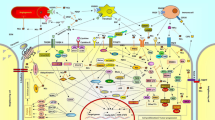Abstract
Exposure of A2780 human ovarian tumor cells to a low concentration of melphalan in vitro for 7 d results in the development of melphalan resistance, which is dependent on elevated cellular levels of glutathione and glutathioneS-transferase. The inclusion of selenite (at concentrations as low as 0.2 ΜM) during the exposure to melphalan completely prevented the development of resistance. Selenite did not prevent the melphalan-induced increase in glutathione, but it did prevent the increase in the activity of glutathioneS-transferase. It also prevented the increase in the expression of the glutathioneS-transferase gene, suggesting that this may be the mechanism by which it prevents the development of melphalan resistance. The results of this in vitro study suggest that selenite may prove to be useful in preventing the development of drug resistance in vivo.
Similar content being viewed by others
References
G. F. Combs, Jr. and S. B. Combs,The Role of Selenium in Nutrition, G. F. Combs, Jr., ed., Academic, New York, pp. 205–263 (1986).
R. F. Burk, Clinical effects of selenium deficiency, inEssential and Toxic Trace Elements in Human Health and Disease, A. Prasad, ed., Wiley-Liss, New York, pp. 180–190 (1993).
C. Ip and F. B. Daniel, Effect of selenium on 7,12-dimethylbenzanthracene-induced mammary carcinogenesis and DNA adduct formation,Cancer Res. 45, 61–65 (1985).
R. LeBoeuf, B. Laishes, and W. Hoekstra, Effect of selenium on cell proliferation in rat liver and mammalian cells as indicated by cytokinetic and biochemical analysis,Cancer Res. 45, 5496–5504 (1985).
J. Milner and C. Hsu, Inhibitory effects of selenium on the growth of L1210 leukemic cells,Cancer Res. 41, 1652–1656 (1981).
H. Petrie, L. Klassen, M. Tempero, and H. Kay, In vitro regulation of human lymphocyte proliferation by selenium,Biol. Trace Element Res. 11, 129–146 (1986).
D. Medina and C. Oborn, Differential effects of selenium on the growth of mouse mammary cells in vitro,Cancer Lett. 13, 333–344 (1981).
J. Golczewski and G. D. Frenkel, Selenoproteins and the effects of selenite on cell proliferation.Biol. Trace Element Res. 20, 115–126 (1989).
A. Watrach, J. Milner, M. Watrach, and K. Poirier, Inhibition of human breast cancer cells by selenium,Cancer Lett. 21, 43–47 (1984).
L. J. Ayash, T. S. Herman, and E. Frei, Cancer chemotherapy: clinical evidence for drug resistance, inDrug Resistance and Oncology, B. Teicher, ed., New York, pp. 617–635 (1993).
P. B. Caffrey and G. D. Frenkel, Selenite cytotoxicity in drug resistant and nonresistant human ovarian tumor cells,Cancer Res. 52, 4812–4816 (1992).
P. B. Caffrey and G. D. Frenkel, The development of drug resistance by tumor cells in vitro is accompanied by the development of sensitivity to selenite,Cancer Lett. 81, 59–65 (1994).
P. B. Caffrey and G. D. Frenkel, Sensitivity of melphalar-resistant tumors to selenite in vivo.Cancer Lett. 121, 177–180 (1997).
P. B. Caffrey, M. Zhu, Y. Zhang, N. Chinen, and G. D. Frenkel, Development of glutathione S-transferase-dependent drug resistance in vitro by short-term exposure of cells to melphalan,Cancer Lett., in press.
P. Chomczynski and N. Sacchi, Single-step method of RNA isolation by acid guanidinium thiocyanate-phenol-chloroform extraction,Anal. Biochem. 162, 156–159 (1987).
T. C. Hamilton, M. A. Winker, K. A. Louie, and G. Batist, Augmentation of adriamycin, melphalan and cisplatin cytotoxicity in drug resistant and sensitive human ovarian tumor cells by buthionine sulfoximine mediated glutathione depletion,Biochem. Pharmacol. 34, 2583–2586 (1985).
R. Ozols and R. Young, Chemotherapy of ovarian cancer,Semin. Oncol. 11, 215–263 (1984).
Author information
Authors and Affiliations
Rights and permissions
About this article
Cite this article
Caffrey, P.B., Zhu, M. & Frenkel, G.D. Prevention of the development of melphalan resistance in vitro by selenite. Biol Trace Elem Res 65, 187–195 (1998). https://doi.org/10.1007/BF02789095
Received:
Accepted:
Issue Date:
DOI: https://doi.org/10.1007/BF02789095




